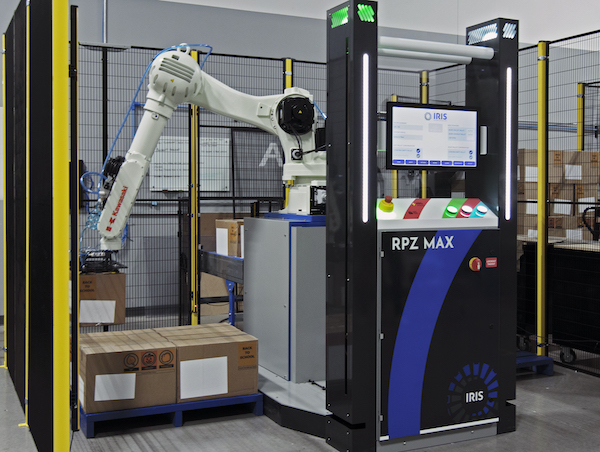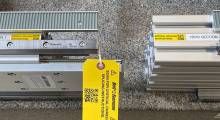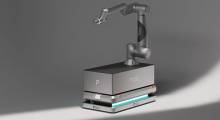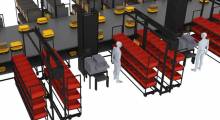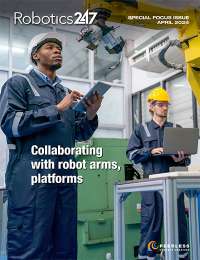As more consumers shop online, many manufacturers are grappling with decreased backstock, increased demand, and labor shortages. Kawasaki Robotics said it will showcase low-cost and entry-level products, as well as high-end automation for end-of-line applications, at PACK EXPO International.
With over 50 years of experience, Kawasaki is a leading supplier of industrial automation and robots. The Japanese company, whose U.S. robotics division is based in Wixom, Mich., said it has with expertise in a wide range of applications and industries. Kawasaki also said it provides “unmatched customer support and after sales service.”
Kawasaki Robotics will be at Booth N-5946 at PACK EXPO International, which will be in Chicago from Oct. 23 to 26, 2022.
Kawasaki partners with IRIS for palletizing
In addition to the need for adequate throughput, manufacturers increasingly need robotic workcells “that don't require dedicated engineers to operate,” noted Kawasaki Robotics.
Kawasaki partner IRIS Factory Automation will show its pre-configured RPZ-MAX palletizing cell, which uses Kawasaki R-series robots for high-mix, low-volume production. The RPZ-MAX is a small-footprint, point-of-use palletizer with two pallet stations with a minimal footprint and sleek design, said the companies.
It can handle payloads from 30 to 80 kg (66.1 to 176.3 lb.) and cycle times of about 6 seconds. The cell enables a variety of palletizing configurations and offers intermittent slip sheet placement, label orientation and verification, and a flexible end-of-arm tool (EOAT).
The RPZ-MAX also includes easy-to-use software and a drag-and-drop, pallet-builder interface, said IRIS Automation. The demonstration at PACK EXPO will include a human-machine interface (HMI) for attendee interaction.
The kiosk is designed to be intuitive, replicate the look and feel of a modern smartphone or tablet, and eliminate the need for complex programming by the user, said IRIS. The Aurora, Ill.-based company added that the RPZ-MAX uses light curtains and protected sensors and cable routing to minimize wear and maximize safety.
“As clients move away from manual labor to something that’s more automated in terms of palletizing, we want to break down the barrier between the fear factor of putting robots on the factory floor,” said Robert Fell, president of IRIS Factory Automation. “We want them to take ownership of the equipment because once that happens, they’re going to fully embrace it and feel comfortable using it.”
PSA Sniper Cell comes pre-engineered with delta robot
Pick-and-place tasks are an essential function of most production lines, but their monotonous nature can make them hard to staff, said Kawasaki Robotics.
To address these challenges, Kawasaki partner PSA designed the Sniper Cell. It integrates a high-speed, long-reach Kawasaki Y-series delta robot, vision sensors, a RS007N material handling robot, and conveyors. The cell is designed for picking, case packing, carton loading, kitting, and assembly applications.
Kawasaki’s Y-series robots are widely used in industrial environments such as food, pharmaceutical, cosmetics, electrical, electronics, and machine parts sectors.
“The Sniper Cell is designed and built as a cost-effective, easy-to-deploy, high-speed automation solution to satisfy the increasing demand from our customers with primary and/or secondary packaging challenges,” said Joe Redding, director of sales and business development at PSA. “The packaging and manufacturing market segments continue to be impacted by rising labor shortages, supply chain issues, and the need for increased hygienic safety.”
The Sniper Cell's pre-engineered, modular design can provide flexibility, and its minimized footprint can easily fit into existing or new production lines, said the companies. It can help manufacturers standardize and scale packaging assembly lines, they added.
In addition, the cell's interface allows users to change operating parameters on the fly so they can quickly adapt to customer demands.
For easy maintenance, the pneumatic system is fully integrated, and the controller is in a top cabinet or inside the cell for easy access. Acrylic access doors act as physical barriers with interlocks for operator safety, noted PSA.
Cell-to-cell wireways can interface, allowing multiple cells to easily join as production expands, the company said.
Kawasaki introduces RS013N robot to North American market
Bin picking can be a laborious, tiring, and even dangerous task, making it suitable for automation, said Kawasaki Robotics. However, shifting part locations and complex path calculations can make it difficult to automate. Kawasaki said its new RS013N robot uses Canon's optical processing technology to pick and sort random parts from a bin to a conveyor.
Since the mid-1980s, Kawasaki said it has refined its R-series robot arms to provide wider working ranges, faster cycle times, longer reach, and increased torque. The RS013N builds on the RS007N/L models introduced in 2017 by offering a 13 kg (28.6 lb.) payload capacity, a small footprint, and IP67-rated dust-tight design.
The RS013N includes a new arm structure and lighter main unit. Its 1,460 mm (57.4 in.) reach allows for installation flexibility and a wider variety of applications, said Kawasaki. The new robot also leads its class in speed, resulting in reduced cycle times and increased productivity, claimed the company.
The RS013N's internal Ethernet wiring enables easy connection to a vision system or other peripheral devices, said Kawasaki. The robot's floor, ceiling, and wall mount options offer installation flexibility.
In addition, the arm has a full-body IP67 rating, fully covered motors, and waterproof electrical connections. The robot can thus be used in food and cleanroom applications.
Kawasaki said its next-generation R series robots (RS007N/L and RS013N) have reduced interference zones around the robot base to maximize usable floor space. The new motor location on the base allows for enhanced protection and easier serviceability.
More products to see at PACK EXPO
Kawasaki Robotics said it will also show the following products in Chicago next month:
RS007L: The company said its high-speed, high-performance robot will be part of a multi-pattern pick-and-place packing cell. The small-scale cell will include fully integrated vision and an area scanner for operator interaction.
“The RS007L offers the fastest operating speed in its class, a small footprint, and vision compatibility resulting in greater packaging flexibility for the food industry,” said Kawasaki.
CP180L: This high-speed robot is capable of palletizing rates of 2,050 cycles per hour, said Kawasaki. It will insert slip sheets, palletize bags and boxes ranging in weight and size, and switch out pallets. Kawasaki noted that the CP180L is equipped with a multi-function Piab tool, enabling it to complete all of these tasks without changing tooling.
Article topics
Email Sign Up

